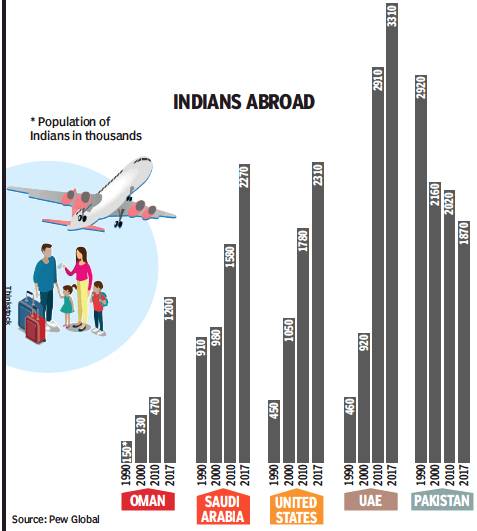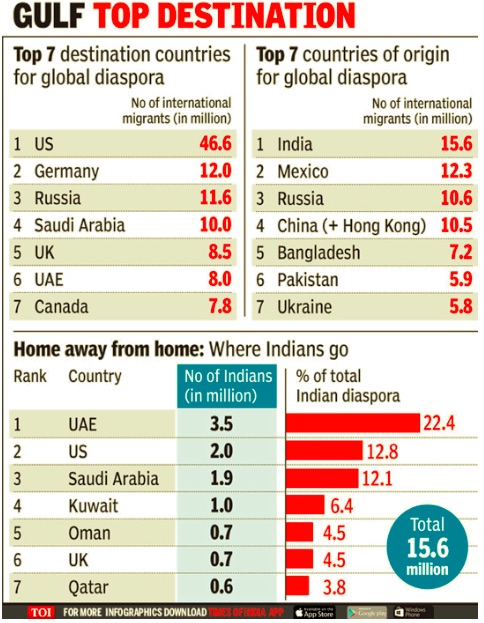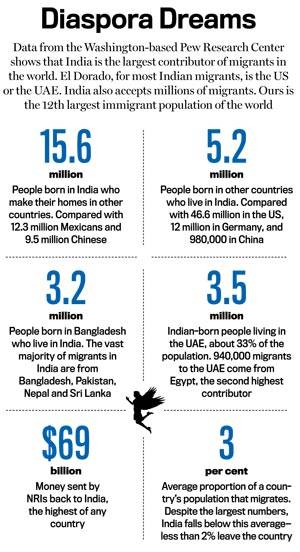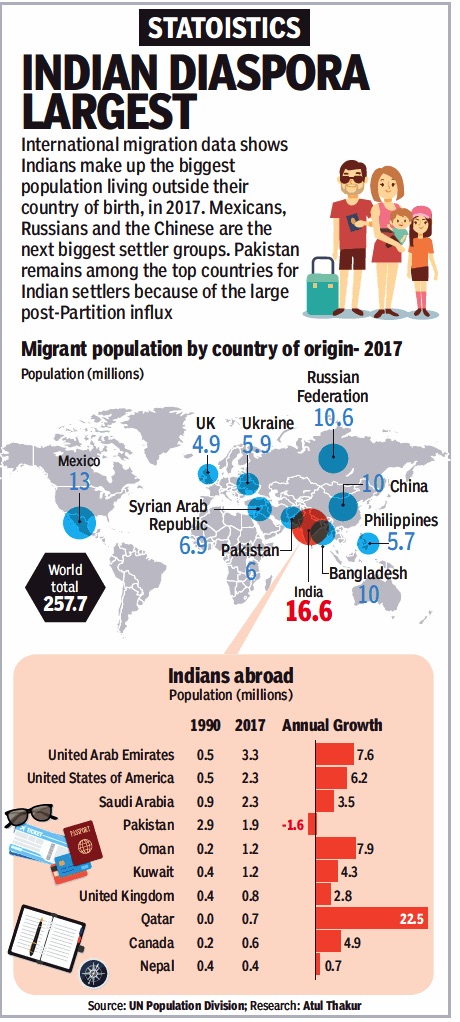Diaspora: India
This is a collection of articles archived for the excellence of their content. |
Countries preferred most by Indian settlers
2018: UAE, USA, Saudi Arabia, Pakistan, Oman
March 25, 2018: The Times of India

From: March 25, 2018: The Times of India
UAE, Saudi Arabia, Oman: Gulf countries remain top draw for Indian settlers
More Indians have settled abroad than any other people in the world. The UN says one out of every 20 emigrants today is Indian. That means about 1.7 crore of us, or roughly the population of Mumbai in 2010. For the UN, anyone who has lived in the same foreign country for more than a year is an emigrant. In which countries are India-born people most heavily concentrated? The UAE, USA, Saudi Arabia, Pakistan and Oman are the top five places now, but Pakistan was number 1 three decades ago. Oman has been the top destination since 2010.
Countries that prefer Indians
2015,’16: OECD countries
The total inflow of new immigrants to OECD countries was 70.6 lakh during 2016, a minuscule rise of less than 1% over the previous year’s figure of 70.4 lakh.
China retained its leadership position, accounting for 7.6% of the inflow. With 2.71 lakh new immigrants, India occupied fourth place and accounted for 3.8% of the total inflow. Over the past two years, migration from India has remained stagnant at 3.8%. However, in terms of standalone numbers, there was a small increase from 2.68 lakh in 2015 ,reports the International Migration Outlook (2018) released by OECD in Paris on June 20.
The Organisation for Economic Cooperation and Development (OECD) comprises of 35 member countries, including European countries, the United States of America, Canada, Australia, New Zealand and Japan.
For the first time, the International Migration Outlook, an annual publication, presented consolidated data on all categories of temporary labour migration. OECD countries were home to over 42 lakh temporary foreign workers during 2016. The main receiving countries for temporary foreign workers were Poland (which had 6.72 lakh workers) and the US (with 6.6 lakh workers).
In 2016, almost 21 lakh people acquired the nationality of an OECD country, up 3% from 2015, even as it remains within the OECD average of the last 10 years. India leads the pack, being the top origin country for naturalised foreigners (1.3 lakh).
Size of Diaspora
See graphic:
The estimated strength of the Indian Diaspora across the world, as in 2017

2015
2015: 1.30 lakh PIOs acquired OECD citizenship
1.3L in '15: India tops list of foreign citizenship, June 30, 2017: The Times of India

India tops the list of origin countries of naturalised citizens across the world, indicating that the diaspora is not apprehensive of acquiring foreign citizenship. In 2015, 1.30 lakh people of Indian origin, comprising largely of expatriates on work visas, acquired citizenship of OECD member countries.This was followed by Mexico (1.12 lakh) and the Philippines (94,000). China came fifth with 78,000 opting to relinquish their citizenship. These were the findings of the report International Migration Outlook (2017) released by Organisation of Economic Co-operation and Development (Oecd) in Paris on Thursday.
The report mentioned that in 2015, just over 20 lakh people acquired the nationality of an OECD country.This was slightly above (3%) the 2014 figure, even as it remains within the Oecd average of the past 10 years.
OECD is a global thinktank of 35 member countries, which include European countries, USA, Canada, Australia, New Zealand and Japan. An earlier Oecd report had pointed out that India had the world's largest diaspora with 156 lakh migrants.
“Improving the integration of immigrants and their children, including refugees, is vital to delivering a more prosperous, inclusive future for all,“ said OECD Secretary-General Angel Gurría in the report.
China retained its top position when it came to new immigrants to OECD countries.However, on this front, the refugee crisis led to a large influx of immigrants from Syria, pushing India down one spot to the fifth position. Humani tarian migration, rather than migration for better jobs or lifestyle, dominated the scene during 2015 and would continue to do so in the immediate future, the report stated. The total inflow of new immigrants to OECD countries in 2015 was 70.39 lakh and new immigrants from China accounted for nearly 7.8% of the inflow. In 2013, nearly one in ten immigrants were from China.
Migration flows from India to OECD also dipped slightly , from 4.4% of the total inflows countries in 2013 to just 3.9% in 2015. However, in terms of standalone numbers, there was an inflow of 2.68 lakh immigrations from India during 2015 to OECD countries, as opposed to just 2.40 lakh in 2013. (see table). Data showed that USA, Canada, UK, Australia and Germany continue to be the favoured destinations of Indian migrants.
Both China and India continued to be the major source countries for international students. Over half of the international students in the OECD countries originate from Asia. Chinese students, despite a 7% drop in their numbers between 2013 and 2014, were the most dominant with six lakh enrolments during 2014. They were followed by Indian students whose number at 1.86 lakh during 2014 was up by 13% compared with the previous year. USA received more than 40% international student enrolments.
2015/ Indian diaspora is world's largest at 16m: UN
The Times of India, Jan 14 2016
Somini Sengupta
UN: Indian diaspora is world's largest at 16m
According to the United Nations estimates, 244 million people, or 3.3% of the world's population, live in a country other than the one where they were born.Their ranks are growing at a faster pace than the world population as a whole, with enormous economic, social and demographic repercussions for their native and adopted countries.
However, they are concentrated in just 20 countries. By far, the most popular destination in 2015 was the United States, followed by Germany , Russia and Saudi Arabia. Indians make up the largest diaspora: 16 million Indians are scattered across the world, which partly reflects the country's demographic size (1.2 billion) and youth (median age is around 26).
After India, Mexico has the second largest diaspora, with 12 million living abroad, the majority of them in the US.
2015, Indians world's largest diaspora
Indians World's Largest Diaspora
The migration of Indians from the country to the United Arab Emirates (UAE) formed the second largest corridor in terms of number of migrants in 2015, according to a report released by the Organisation for Economic Cooperation and Development (OECD).
The flow of migrants from India to the UAE between 1995 and 2015 stood at 28 lakh, making UAE the top destination country for Indian migrants (It ranked fourth place in 1995).
The corridor between Mexico and the United States remains the largest in terms of the volume of migrants. In 2015, the flow from Mexico to US stood at nearly 55 lakh. Migration flow between 1995 and 2015 has been computed by OECD by taking the difference between the number of migrants in each of these two years.
In 2015, Indians accounted for the largest diaspora in the world with 156 lakh migrants, according to OECD's report -`Perspectives on global development, 2017: International migration in a shifting world.' The report points out that 24.3 crore people were living outside their country of birth in 2015, accounting for 3.3% of the world's population. This was a significant increase over the past twenty years -in 1995 only 2.7% of the world's pop ulation comprised of diaspo ra. The move of migrants has increasingly been towards high income countries.
The number of migrants from India living in the UAE grew by 126% between 2005 and 2010, accounting for nearly 20% of the global Indian mi grant stock in 2015 (In 1995, this constituted just 9% of India's diaspora). Immigrants now account for almost 70% of the total population in Kuwait and more than 80% in Qatar and the UAE. Indians are the sec ond largest immigrant group in the US, after Mexicans ac counting for 4.7% of the 413 lakh foreign born population.
A significant portion of Indi an immigrants in the US AS are recent arrivals: 51% of the total Indian born population arrived during or after 2000, compared to 36% of the foreign born population as a whole.
As regards the future, OECD's report said increasing protectionist measures were being adopted by high income countries, which should see a shift in the migration trends.
2016: India, Pakistan, Bangladesh and the world (in 2016?)
Lubna Kably, December 15, 2017: The Times of India
See graphic:
i) The countries to which Indians go;
ii) Top 7countries of origin for global diaspora;
iii) Number-Percentage of Indian diaspora, country-wise

ii) Top 7countries of origin for global diaspora;
iii) Number-Percentage of Indian diaspora, country-wise.
All figures presumably for 2016.
From: Lubna Kably, December 15, 2017: The Times of India
HIGHLIGHTS
Out of a global population of 7.3 billion, one of every 30 people was a migrant in 2015.
The Indian diaspora constitutes 6% of the total number of international migrants.
The Indian diaspora is the world's largest, with slightly more than 15.6 million people from India living overseas. The Indian diaspora constitutes 6% of the total number of international migrants (people living outside the country of their birth), which was estimated at 243 million in 2015. The global figure has risen by 10% over that recorded in 2010, a recently released United Nations report said.
In other words, out of a global population of 7.3 billion, one of every 30 people was a migrant in 2015. However, if computed as a percentage of the world's population, the growth of thediaspora has been largely static, from 3.2% in 2010 to 3.3% in 2015, according to the 'World Migration Report (2018)', published by the International Organisation for Migration, a UN agency.
According to the report, nearly half of all the international migrants worldwide in 2015 were born in Asia, primarily originating from India, China and other South Asian countries. After India, Mexico has the second largest diaspora. Russia, China, Bangladesh and Pakistan follow (see graphic). Notably, people in the working age group, between 20 to 64 years, account for a significant chunk of the international migrant population, nearly 72%. Since 1970, the US has been the main destination for international migrants.
The number of foreign-born people residing in the US has almost quadrupled from fewer than 12 million in 1970 to 46.6 million in 2015 (of whichnearly two million were of Indian origin). The Gulf nations house the biggest share of the Indian diaspora — nearly 3.5 million or 22% of the total Indian diaspora were in the UAE, and 1.9 million (or 12%) in Saudi Arabia.
According to immigration experts, protectionist measures adopted in these and other countries will eventually transform the diaspora landscape. We are witnessing intense vetting of applications for H-1B, the most popular work visa for Indians headed to the US, and entry into the US is likely to involve stricter rules.
The number of migrants to the Gulf has dipped drastically in recent years, owing to economic conditions and the protectionist measures adopted by these countries. As reported earlier by TOI, pan-India emigration clearance for the Gulf in 2016, 5.07 lakh, showed a decline of 33% as compared to the previous calendar year. The decline trend has continued in 2017.
2017: Indian migrants abroad, Foreign born immigrants in India
India Today Web Desk , Diaspora dreams “India Today” 20/3/2017
See graphic

“India Today”
2018: India, Pakistan, Bangladesh and the world

From: March 27, 2018: The Times of India
See graphic:
Migrant population by country of origin, 2017
2019/ At 17.5m, Indian diaspora largest in world
Lubna Kably, Sep 19, 2019: The Times of India

From: Lubna Kably, Sep 19, 2019: The Times of India
At 17.5 million, India’s diaspora continues to be the largest in the world – constituting 6.4% of the total world migrant population of 272 million in mid-2019
NEW DELHI: At 17.5 million, India’s diaspora continues to be the largest in the world – constituting 6.4% of the total world migrant population of 272 million in mid-2019.
While India’s diaspora in absolute numbers has increased 10% from 15.9 million in 2015, as a share of total world migrant population, it’s remained static, according to the UN’s International Migrant Stock released on Wednesday. And it trails the 12% rise in total migrant population, which was 243 million in 2015.
UAE, US and Saudi Arabia – with 3.4 million, 2.6 million and 2.4 million respectively – were the top three destinations for Indians, according to TOI’s analysis of the data. While the Gulf countries continue to have a high concentration of Indians, they’ve lost some of their drawing power, going by foreign ministry figures.
Another report – also released on Wednesday – by OECD, shows Indians moving up one position to No. 3 in 2017 with an inflow of 3.04 lakh – behind China and Romania.
The number of Indians who got US citizenship in 2017 rose 10% to more than 50,000 over the previous year.
UN figures pegging international migrants worldwide at 272 million reflects a rise of 23% over 2010 data, where the migrant population was 221 million. UN’s data set is based largely on collated census figures. UN defines international migrants as anyone who changes their country of usual residence, irrespective of their motive – be it for work or as a refugee.
“Although migration is global, most journeys are taking place within a limited set of countries, with the US, Germany, and Saudi Arabia making up the top three,” said a UN press release. The US hosted the largest number of international migrants (close to 51 million), followed by Germany and Saudi Arabia, with nearly 13 million migrants each. The UN’s press release quoted John Wilmoth, director, UN’s Department of Economic and Social Affairs (DESA) saying: “The link between migration and development is very well established.” "As a general observation, the contribution of migrants both in host countries and countries of origin, includes sending valuable remittances back to countries of origin, and a major social contribution through transmission of ideas," he said.
Another report, released in Paris, by the Organisation for Cooperation and Economic Development (OECD), shows that migration flows to OECD countries rose slightly by 2% in 2018, with around 5.3 million new ‘permanent’ migrants–this does not include temporary labour migration or international students.
Country-wise data for the year 2017 shows that ‘total’ inflow of new migrants to OECD countries in 2017 was 6.8 million, a miniscule decline of 1% over the previous year’s figure. The top three countries of origin of new immigrants were China, Romania and India.
With 3.04 lakh new immigrants from India, the country occupied third place and accounted for 4.5% of total inflows (as opposed to 3.8% in the previous year). In 2016, owing to a heavy influx of migrants from Syria, India had occupied fourth position. China continued to retain its leadership position, accounting for 8.1% of total OECD inflows in 2017. Countries continue to adjust the criteria on which their labour migration programs are based to ensure better selection and meeting of their skill gaps. Canada’s Express Entry route for skilled labour was modified in late 2017. Australia significantly reformed both its temporary and permanent employer sponsored migration programs for skilled labour in 2018, illustrates OECD’s report.
The majority of developed and high-income countries (36 in all) are OECD members. These include European countries, US, Canada, Australia, New Zealand, and Japan. Gulf countries, which are an important destination for Indian immigrants, do not belong to the OECD group.
In 2017, around 18.5 lakh foreign residents in OECD countries acquired the nationality of their host country. This is a sharp drop of 11% compared with 2016 when almost 21 lakh people obtained such citizenship. India’s ranking dipped to second in this category, with 1.21 lakh obtaining citizenship of an OECD member country during 2017 as opposed to 1.3 lakh in the previous year. Mexico stole a march over India and became the main country of origin of new citizens of OECD countries in 2017 with 1.22 lakh citizenships being acquired – the majority being in US.
As regards the Indian diaspora, more than 50,000 acquired US citizenship (a 10% rise over the previous year). Also, 10,000 Indians acquired Canadian citizenship and 17,000 obtained British citizenship. These statistics showed a decline of 40% and 33% respectively.
2021
1.3cr Indians live in foreign nations
The home ministry informed the Lok Sabha that 1.3 crore Indian nationals were living in foreign countries. Also, 1.1 lakh Indians gave up their Indian citizenship till September 30 this year, up from 85,248 in 2020, but lower than 1.4 lakh in 2019, 1.3 lakh in 2018 and 1.3 lakh in 2017. As many as 10,645 foreign nationals applied for Indian citizenship between 2016 and 2020, of which 7782 were Pakistanis.
2024/ 25: The size of the Indian diaspora, country- wise
This table was published in February 2025 and, at best, represents 2024 figures. A further note of caution: all statistics about the size of the Indian diaspora in any country are guesstimates.
|
Rank |
Country |
Indian
Immigrant Population (approx.) |
|
1 |
United
States |
4.5
million |
|
2 |
United
Arab Emirates |
3.5
million |
|
3 |
Saudi
Arabia |
2.5
million |
|
4 |
Canada |
1.9
million |
|
5 |
United
Kingdom |
1.8
million |
|
6 |
Australia |
700,000 |
|
7 |
Kuwait |
600,000 |
|
8 |
Qatar |
500,000 |
|
9 |
Oman |
400,000 |
|
10 |
South
Africa |
300,000 |
PIOs in top govt leadership positions
200 PIOs are top govt leaders in 15 countries:/ 2020
February 17, 2021: The Times of India
200 PIOs are top govt leaders in 15 countries: Study
Washington:
More than 200 Indian-origin people occupy leadership positions in as many as 15 countries, including the US and the UK, building a legacy for future generations, according to a first-of-its-kind list by a USbased organisation working among the Indian diaspora.
The 2021 Indiaspora Government Leaders List, which was released on Monday, had drawn from government websites and other publicly-available resources to prepare the report to showcase the achievements of the community leaders across different sectors. It said that more than 200 leaders of Indian heritage have ascended to the highest echelons of public service in 15 countries across the globe, with over 60 of them holding Cabinet positions.
“It is a huge source of pride to have the first woman and first person of colour as the Vice President of the world’s oldest democracy be someone of Indian heritage. We wanted to use this seminal moment on Presidents’ Day to highlight a host of others in the diaspora who also are in public service,” said Indiaspora founder M R Rangaswami, a Silicon Valley-based entrepreneur and investor. He was referring to Kamala Harris, the first woman of US.
“These leaders are building a legacy for future generations, and one that extends beyond our community to all of the constituents and communities that they serve,” Rangaswami said in a statement. The list also includes diplomats, legislators, heads of central banks and senior civil servants from countries with significant histories of diaspora migration, such as Australia, Canada, Singapore, South Africa, the United Arab Emirates, the United Kingdom and the United States.
“As the longest-serving Indian-American member of Congress, I am proud to be a leader in the Indian-American community, which has become an integral part of American life and society,” said Congressman Ami Bera, Chairman of the US House Foreign Affairs Subcommittee on Asia.
With more than 32 million people of Indian-origin or (PIOs) globally, according to India’s ministry of external affairs, Indians are the largest diaspora population in the world.
The officials on the 2021 Indiaspora Government Leaders List collectively represent more than 587 million constituents. PTI